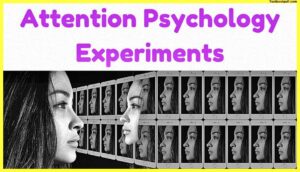Attention psychology experiment (Part-4)
In this article, we will talk about Attention and Visual Perception. Attention psychology experiment (Part-4) We will focus on inattentional blindness and change detection. This article also focuses on Overt and Covert attention, it closes with location and object-based attention.
Now we have been talking in the last three articles about attention we have seen that there have been theories of attention that talked about attention as a selective strategy we also talked about filter theories in bottleneck theories of attention we were also talking in one of the articles about how you use attention say for example the first article on attention that I took and I talked about theories of visual search that were one example wherein you use attention to navigate your environment wherein you are basically using aspects of attention to look for or to search for particular objects from the environment we saw that feature search does basically involve looking for a specific feature or let us say conjunction search involves looking for a specific set of features may be a combination of one or two features and how do you actually focus on one feature or two features and look for a particular object in your environment we have talked about Lots of Things.
In the second article, we give you full info about theories of selective attention how is it important to select a particular piece of information or object or a location from your environment and work on that and what are the different theories of selective attention in the third article we talked about divided attention and that given that it is a basic and it’s a good a profitable ability that we have that we can sometimes if the need arises focus on more than one stimulus or more than one location at a time and we looked into some theories of that and also at the end of that article we talked about how to say for example this divided attention thing can be misused say for example for people trying to do two tasks at the same time when the task is something as demanding as driving in this article today I will basically take you to form a link between attention and perception.
Attention and Visual Perception
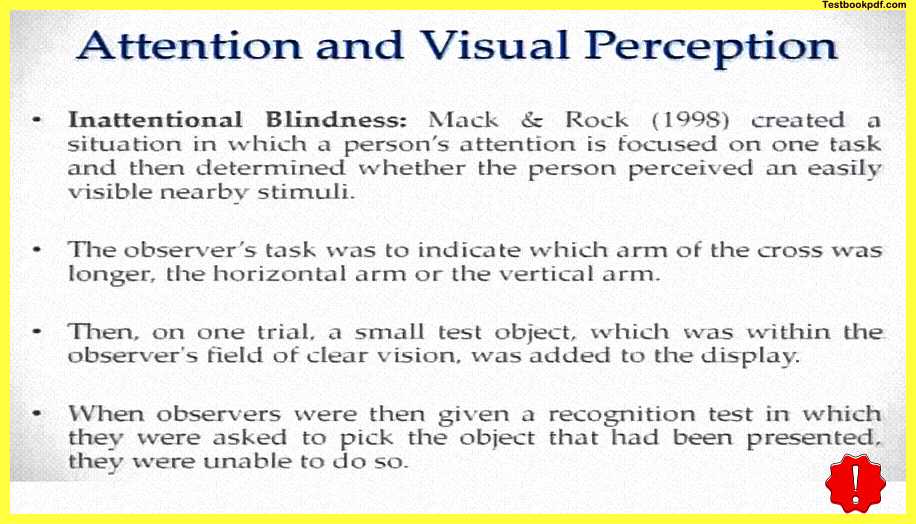
Now, if you think of what an individual does while interacting and navigating with the environment and if you remember some of the earlier discussions we have had we have constantly been talking about the need for selecting some information from the environment and working on it and in that sense, you would see that attention does not only help us do that but attention because it is helping us select and single out some particular region or location or event in time and to attend on that it is doing something with our perception as well what happens when you select something when you attend something and what happens when you do not attain the object in question.
Today we will try and make this link between attention and visual perception by the help of some experimental studies some very famous studies that have been done in attention over the past decades we will try and make this connection and we’ll try and see how this connection can help us better understand the process of attention just to again remind you for the overall scope of the course we have been doing specific cognitive functions but we have also looked into how these cognitive functions interact with themselves because that is what the story of cognition has to be about this is a course on basic cognitive processes and i am trying to tell you that how these basic cognitive functions interact with each other sometimes start working together to give you a more holistic experience to give you more control and to give you a better handle over interacting with the environment we have talked about sensation we talked about perception if you remember the last section on perception was about perception and action.
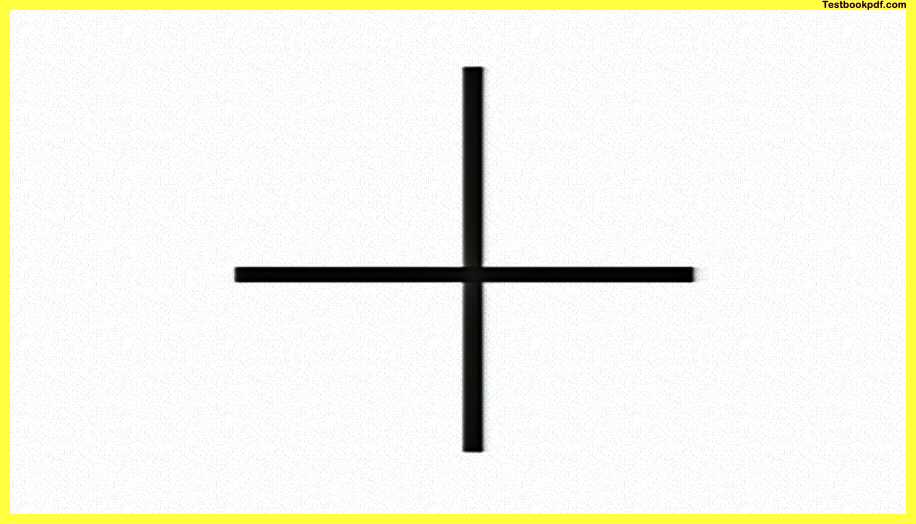
So how do you perceive the environment around and how do you act the second chapter was basically about attention and today I am going to try and help you to connect attention and perception together so if you kind of following all of these articles in a particular sequence if you try and integrate them into a particular conceptual structure you would want to make attention perception and action all linked up with each other and then try and understand how each of these cognitive functions in their own right and in conjunction gives an individual a better chance to interact and navigate with the environment so with that background.
let us try and study one of the very famous phenomena in attentional research which has been around for quite some time called inattentional blindness, MCI rock in 1998 created a situation in which a person’s attention is focused on one particular task and then they try to determine whether the person can perceive another stimulus which is another visual stimulus easily or he has difficulty in doing that the observers task in this kind of setup was basically to indicate the setup i just described the setup how it looked like so there was a blank screen there was a fixation cross, a fixation cross is essentially a plus sign which is presented in the middle of the screen.
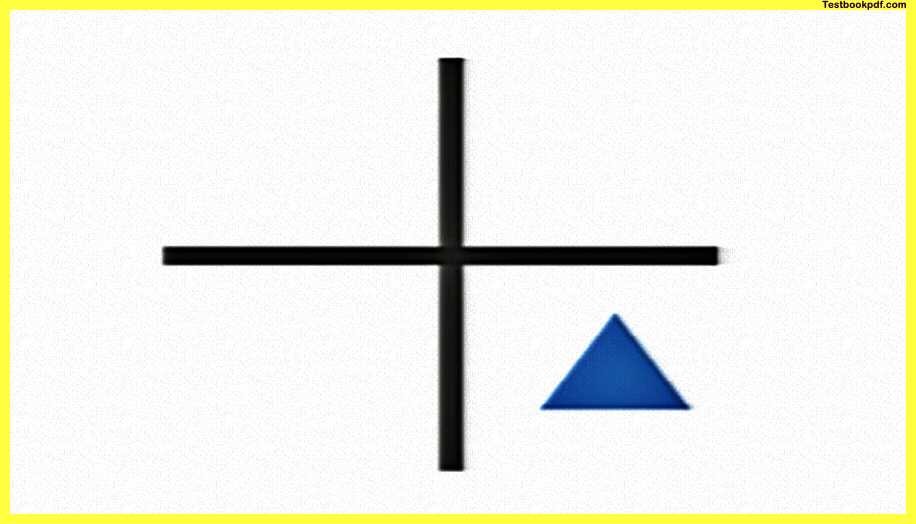
So the observers were given the task of determining which of the arms of this particular cross is longer so there is a plus sign one of these arms maybe the vertical or the horizontal will be longer than the other and this is what the participants were told that you have to figure out and tell and they were told that you have to do it as quickly and as accurately as possible one of these trials while the participants were doing this a small test object it could be of any particular geometric shape which was also within the clear line of vision of these participants was presented observers were basically then given a recognition test after this in in which they were asked to pick up the object that was presented along with the fixation cross so if you see the setup the setup is there are two tasks here the first task is to determine the the length of the arm which of the arm is longer of this fixation cross and the hidden task or the other task is to actually determine which of the shapes will be presented randomly at some point in time along with this fixation cross so this was the setup let me give you a demonstration of this right here right.
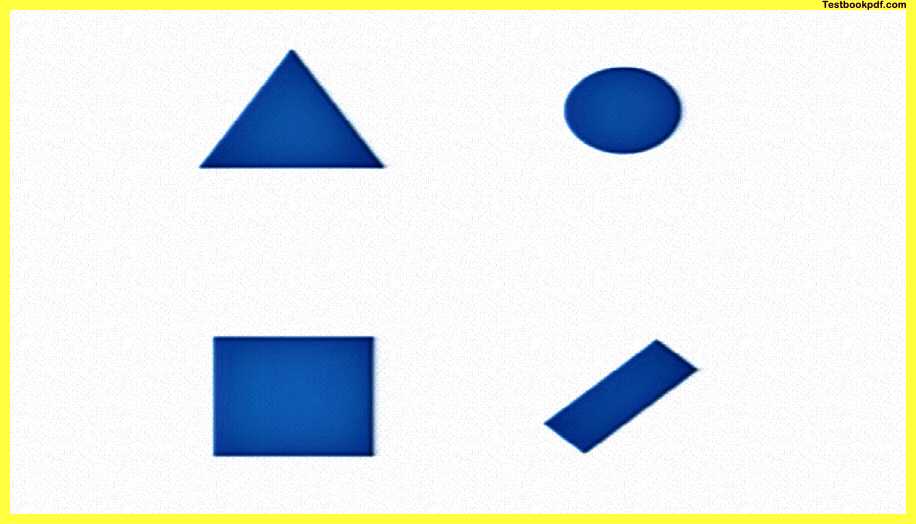
For example this is the fixation cross this is the object and now can you tell me which was the object presented i think it kind of went much slower than it would have gone in the typical experiment but i hope you got the idea so if you’re actually focusing on determining the length of one of these arms of the fixation cross you will have to look at it in a very focused manner it will probably not appear as big in the center of the screen the situation might be slightly different but the task is just determine which of these arms is longer and slightly demanding task and then while you just focus on the arms length you will see some of these kinds of figures some of these geometry shapes appearing right in front of your eyes right where this target in question that is the plus sign is there and then later after asking you which of the arms was a lot longer or which of the ones was shorter i will present you or they presented an array of geometrical stimuli wherein one of these objects which were presented earlier will also be there so you have to recognize which on the objects really appeared with the fixation cross and suppose if you were completely engrossed in the task of judging the arm’s length you will more probably not be very good at recognizing this particular visual object.
Inattentional Blindness
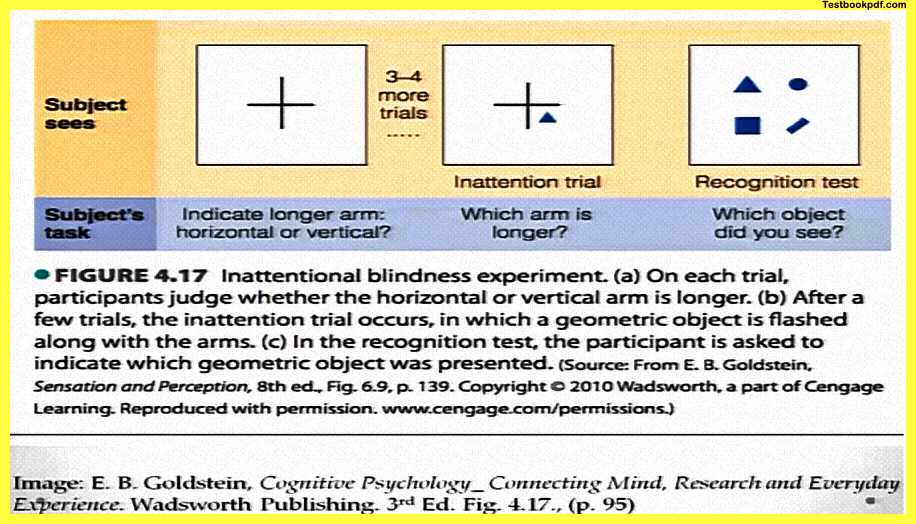
Now, this basically this phenomenon has been termed inattentional blindness if you are not paying attention to something you are blind to that so if you are not really able to attend to a particular stimulus.
Now, this is the entire setup which was again presented in Goldstein’s book of cognitive psychology figure 4.17 this is the whole setup so the description of the phenomena is such that if you are not really paying attention to a visual stimulus or an auditory stimulus as it may in your environment you are almost blind to it mind basically means you are not really attending to it.
Now remember we have talked about selective attention and we talked about divided attention and one of the theories we’ve said that maybe we are still attending that but for most practical purposes we might still be we might be blind to everything that we have not on it we have not attended so to just define this in a more concise way paying attention to all of these to the vertical and horizontal arms of this fixation cross apparently is making the observers blind to the unattended test object this phenomenon has been termed as inattentional blindness.
Now mac and rock demonstrated inattentional blindness using rapidly flashing geometric stimuli but there have also been other kinds of research that have shown that similar effects can be achieved in more natural scenarios as well ok so let me describe one of the other kinds of the experiment here again to do with intentional blindness so Simone Simmons in Chabris basically in 1999 they created a situation in which one part of a scene is attended and the other part is not so it’s a more natural scenario they created a 75 second film and they basically showed two teams of three players each playing basketball in a more natural kind of a setting and in the one in white passing the basketball around so there are the two teams playing this one team which is white wearing white the other team might be wearing a colored jersey and this team is basically following passing the basketball around.
Now observers who were made to watch these movies were asked to count the number of passes so a task that focuses their attention on this ball passing activity is very well ok so they are basically attending to this team in white which is actually passing the ball around.
Gorilla Experiment
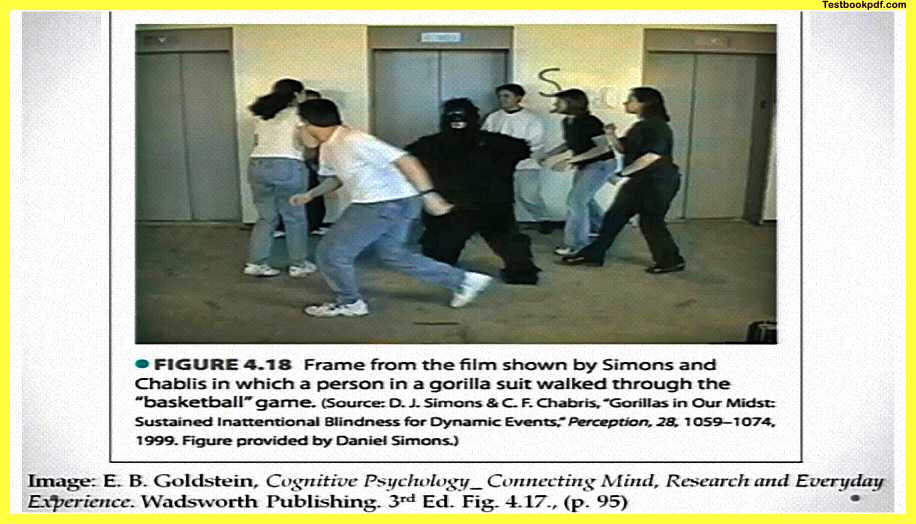
Now, what happens was that after about 45 milliseconds an event that took around 5 seconds occurs so one of these events said, for example, a person dressed in a gorilla suit walks right through the middle of this movie and right through the middle of these players.
Now after seeing the video observers after they actually attended the video they saw the video and they were not really told that there will be a gorilla or something like that happening they were just told to count the passes that happened.
Now after this thing was going on the observers were asked whether they had seen anything unusual happen or whether they had seen any more than six players or something like that nearly half of the observers who saw the movie around 46 percent of the observers they failed to report having seen the event even though it was clearly visible even though it was happening right in front of their eyes but they could not report it why they could have missed it is probably because they were too intent too much caught in counting the ball passes that way this is again a figure of that particular movie just a snapshot from there presented in Goldstein.
So this basically shows you that there is a gorilla standing right in the middle and kind of I’ve seen that movie so he kind of does a few activities and tries to gain attention but if there is somebody who is completely intent on just counting the ball passes and is really very in gross or concentrated in that task might still miss noticing the gorilla and in that sense being blind to whatever is happening this is another example of intentional blindness that which shows us that this is a real phenomenon and may happen quite a few times it might also I mean you might recall saying for example if you are in a party or somewhere you are talking to somebody if somebody who there are the other people who pass around kind of waves at you and you do not notice because you are too engrossed in a particular conversation.
Find the Difference Experiment
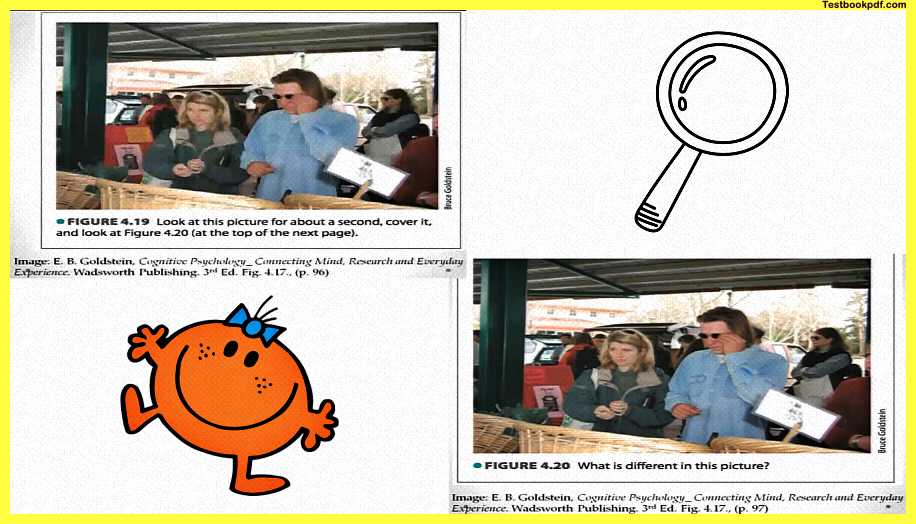
Now moving further let me just give you another task you see this picture here and now you can tell me whether there is a change in the picture so again I am not really sure what the video quality will be like but you can see it here and here if you notice any change now what happens here is again if I try and do this slightly more closely you will see that right next to the women there is a yellow colored poster pasted on that placard and that yellow poster is not really present is not aware is not available in this picture so this is what is happening this is basically called a change scenario so something in the demonstration changes in a blink of a second and a lot of times because you are not attending to the whole picture at once you might miss this change these particular phenomena is called change detection.
Now Resnick and colleagues basically did a very similar experiment in which pictures were alternated in the same way until observers were able to determine what was different about the two pictures so they actually presented a whole lot of pictures and they actually asked the participants to keep track of whether they are there is any change or if there is any change to report that participants basically were presented this with this kind of sequence of pictures again and again and it continued until they were able to determine what was different about the two pictures and found that the pictures had to be alternated back and forth a number of times before the difference was detected the experimenter had to do it quite a few times to really get that change detected by the participants.
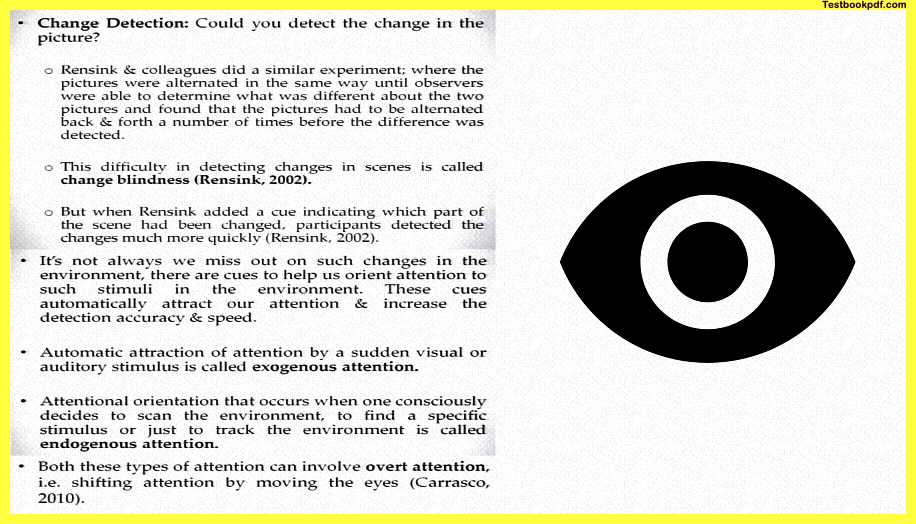
Now, this difficulty in detecting changes in scenes is basically called change blindness proposed by Rensink in 2002, now this is again one phenomenon that is very demonstrative of the fact that attention is so much more important to select relevant information to select relevant stimuli from our environment and do and say for example if there is important information you would want to know that you can say for example liken this to a scenario when you’re going somebody’s asked you to look for a particular landmark and you’re kind of going and you do not notice that particularly maybe it is a poster on the road you kind of miss it because you are talking or you’re kind of attending something else.
No, when Rensink added a queue indicating which part of the scene had changed participants quickly detected the change so this can help if there is a cue that can grab attention and which can orient your attention towards the site where the change has to be made so rinsing in that sense they add he added a cue indicating which part of the scene so which spatial location in the scene is going to be changed and that kind of change is going to happen then the participants certainly could detect these changes much more quickly moving ahead it’s not really often that it’s not always that we miss out on such kind of changes in the environment because there are obviously cues that help us to orient our attention towards such stimuli in the environment.
Now there is an importance of these cues, these cues automatically grab our attention they automatically attract our attention and they increase therefore the detection accuracy and the speed with which we will respond to these kinds of stimuli automatic attraction of attention by a sudden visual or audited stimulus is called orienting of exogenous attention exogenous because the locus of the attention is outside the individual there are obviously a lot of time if you are doing something very interesting you kind of or maybe driving or something you’re doing if there’s a flash of light or if there’s a particular kind of a sound which is distinct from all other sounds you will certainly get oriented towards it that is basically called orienting of exogenous attention.
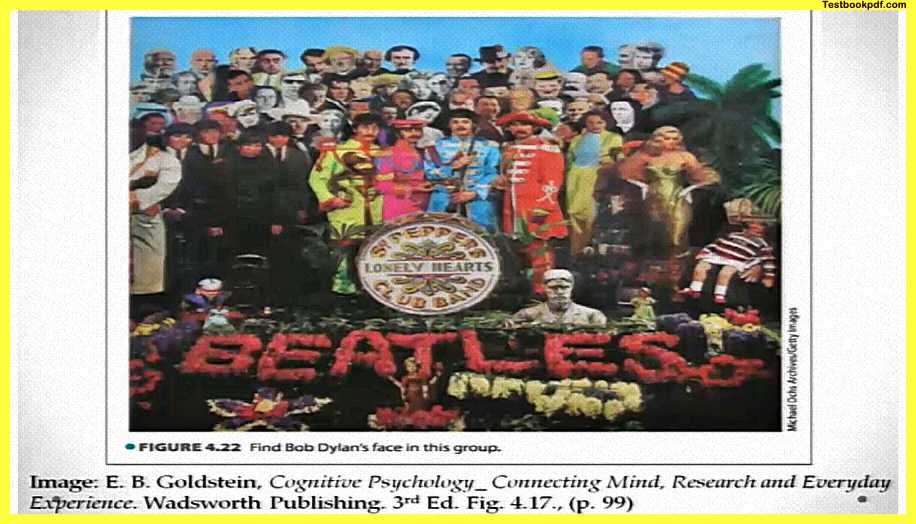
Now attention orientation that occurs when one consciously decides to scan the environment to find a specific stimulus or just to track the environment is called endogenous attention, so the first part I was describing was exogenous attention where the stimuli themselves attract your attention they themselves grab your attention you get oriented towards them it does not happen always sometimes as if you remember in the visual search phenomena you are looking for something.
For example on a railway station or say for example on an airport you have gone to receive somebody and there are too many people coming out all of their faces you’re scanning and you’re actually looking for a particular face you’re looking for a particular person that you’ve gone there to pick up that orienting of your attention which is basically decided by you which you are consciously controlling and manipulating is called endogenous attention, so how you orient your attention in the environment can be of two ways either the stimulus is grabbing your attention or you are looking for that kind of stimulus say for example in a visual search kind of a phenomenon.
Overt Attention
Now both these types of attention can and cannot involve overt attention so we will talk about the case where they involve detention what is overt attention if you remember at the beginning of the attentional chapter I was talking about overt and covert attention overt retention is attention that is manipulated that is controlled by the shifting of your eyes or by moving of your eyes and this definition is taken from Carrasco’s work in 2010.
Now suppose I am showing you this particular picture and I ask you to find the face of bob Dylan in this particular picture so I am kind of again taking it off and I am bringing it on and now I am asking you that out of all these people here in this picture what you have to do is you have to look for and find the face of bob Dylan what are you doing here you’re consciously directing your attention probably scanning each of these faces each of these pictures present you’re going sequentially maybe or maybe you kind of have a sense and you something pops out you’re doing all of that on this picture and how are you doing this you’re basically moving your eyes in an eye-tracking study you could actually also find out How do you move your eyes over to Tension with eye Movements? basically, it can be tracked using a particular device called the eye tracker.
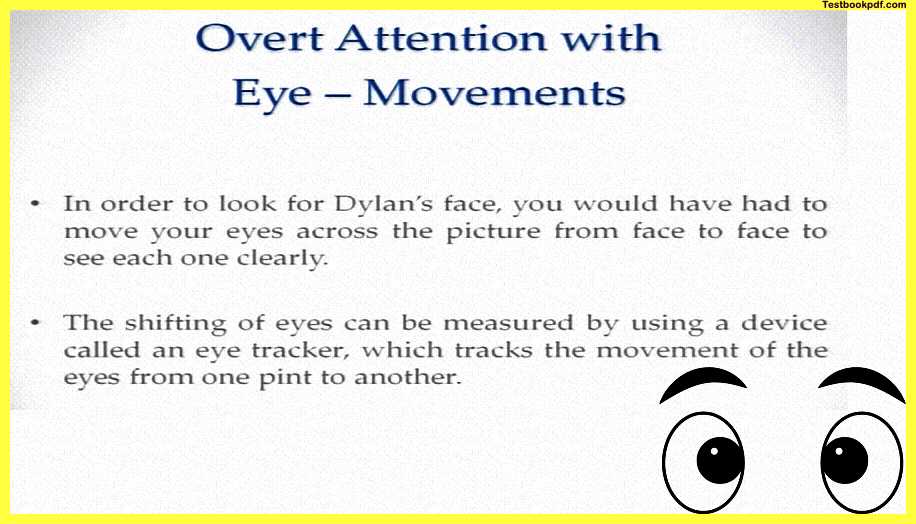
What is an eye Tracker?
The eye tracker is a very simple device basically a camera and a light source the light source kind of throws a light tray in your eyes and that light ray is reflected and the camera tracks the reflection of this right light right and it in that sense it can track the movement of your eyes it can track where your eyes are looking at any point in time so it tracks the movement of I from point one to point two or fro from one point to another.
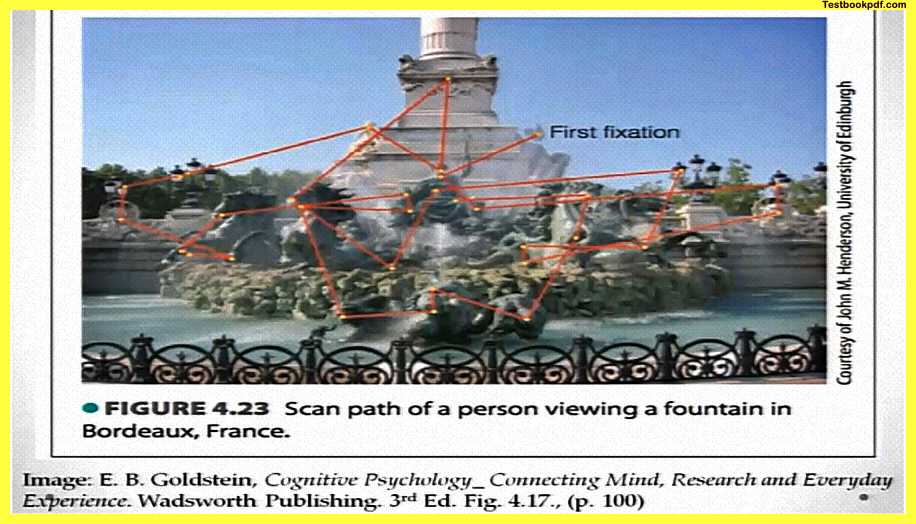
Now suppose there is this thing if you are kind of looking at a particular fountain and there is this study which was done if you are looking at this picture of the fountain in both of France this is the pattern of eye movements that was observed so the first point wherein your eyes land and then they start moving all over the picture the first point is called the first fixation. so wherein your eyes landed at the first all these small dots you can see here all these yellow dots are called fixations because the eyes moved from point a to point b and stayed there for some amount of time that amount could be.
For example, the minimum amount that fixation could be is around 80 to 100 milliseconds your eyes are staying there and then they are moving towards other points so those these small dots are called fixation points, when you’re moving your eyes along these lines from points a to point b you’re doing something called a saccadic eye movement, so what you’re doing is you’re moving the eye from one fixation to the next fixation that is psychotic eye movement typically people make about three fixations per second when viewing an unfamiliar scene something like this if i give you a scene to scan and tell me and find out something in that particular in that scene you will be taking around three fixations per second.
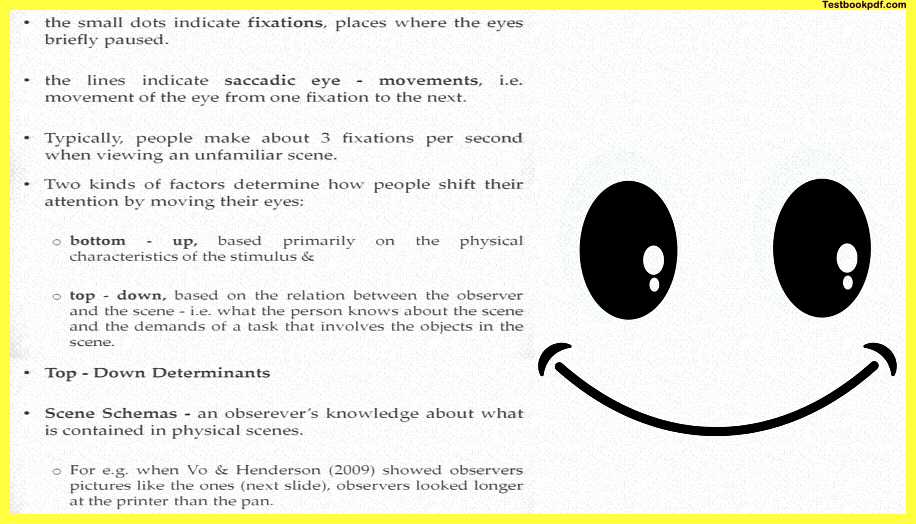
Now two kinds of factors determine how people shift their attention by moving their eyes first is bottom-up factors basically based on the prima primary physical characteristics of the stimulus if there is a bright color if there is a unusual shape that might attract your attention better than some other things so these are bottom-up driven eye movements the other thing would be the top down base i based on the relationship between the observer and the scene when the person looks at the scene and the demands of the task involve the person to scan the scene say for example in the picture when i asked you to look for bob Dylan what you’re doing here is you’re basically doing top-down governed eye movements you basically decided that i have to look for something and that is why you are moving your eyes over this picture again and again some top-down determinants we can talk about so scene schemas and observers knowledge about what is contained in the physical scenes if you’re looking at a particular scene.
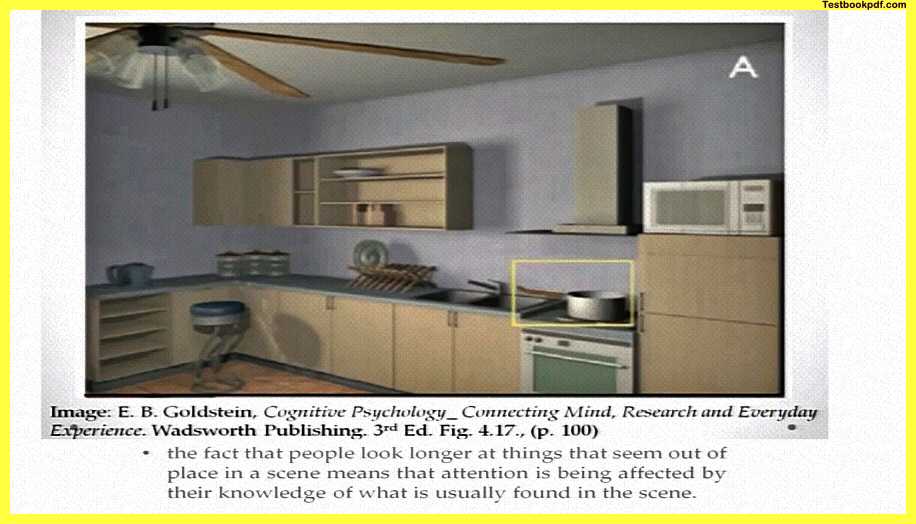
If you’re looking at a particular scenario something about that scene and in that sense maybe you’re looking for something from that scene and that is basically wherein you are doing your top-down kind of I move you’re deciding I can take one example when vo and Henderson in 2009 they showed observers pictures like the ones show you right away observers looked longer at the printer than the pen I’ll just show you this picture right away if you see these pictures again is again a scene of the kitchen but here you can see that there is a pan in the first picture but there’s a printer on the second picture at the cooktop.
Covert Attention
Now there is something interesting about that scene isn’t it you do not expect to find a printer in the kitchen, especially over the cooktop okay so because there is something very specific about that thing that actually made people look longer at that printer so the fact that people look longer at things that seem out of place in a particular scene kind of tells us that attention is being affected by their general knowledge about the scene their general knowledge of what is usually to be found in a particular scene eye movements can also happen or say for example attention can also move from one place to another without moving your eyes so I was hinting about this I think in one of the earlier classes as well the movement of attention the without the movement of eyes is referred to as covert attention so shifting of attention without moving the files is called covert attention.
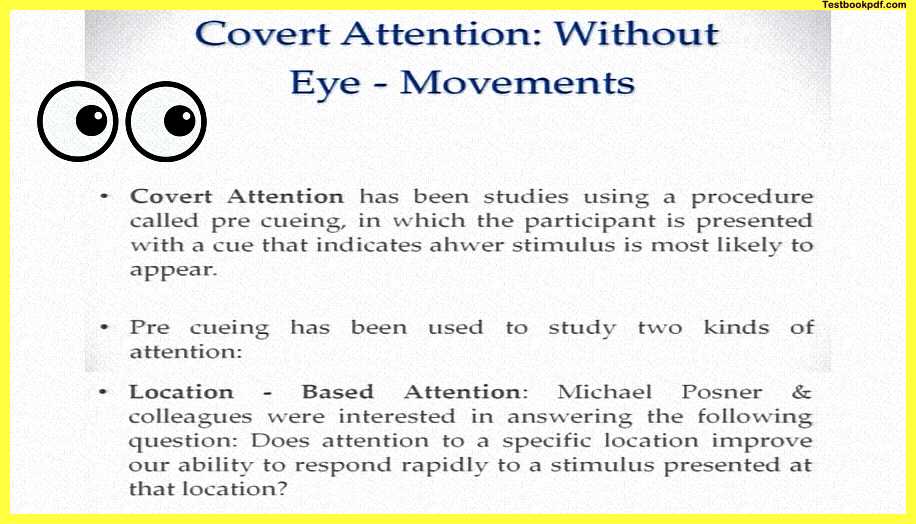
There have been a lot of studies in which covert attention has been investigated and they have used a procedure called pre queuing so in which a participant is presented with the queue that indicates where the stimulus is most likely to appear so pre-cueing has been used to study two kinds of attention I’ll just tell you so first is the location-based attention Michael Posner did these kinds of studies
So Michael Posner and colleagues were interested in answering the following question, the question does attention to a specific location improve our ability to respond rapidly towards stimulus presented at that say for example if there is a location and I have already told you that I am going to present a number here and then I quickly present some numbers and ask you later that which were the numbers presented here because I have already told you the location because you have already oriented your attention towards that particular location your performance will be slightly better as compared to if I am not really telling you where the stimulus is going to appear and then I present a particular stimulus that will be called location-based.
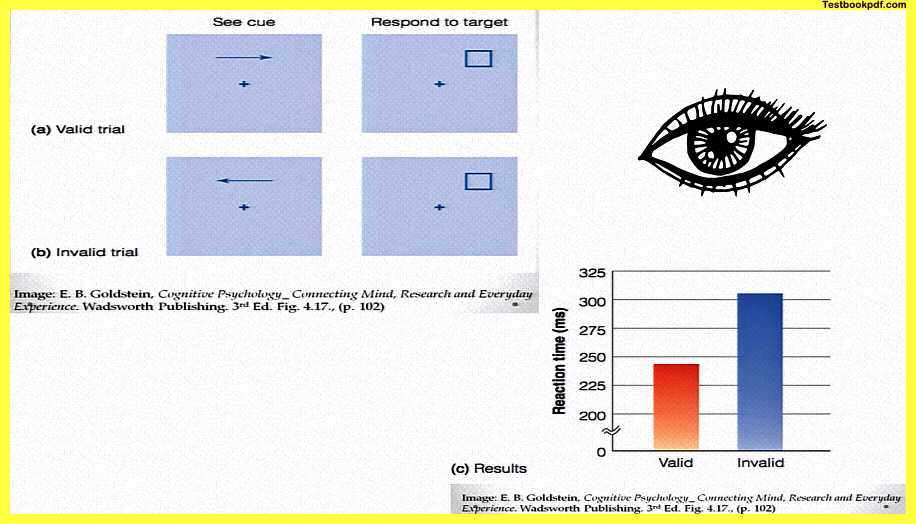
For example in this experiment which was again borrowed from Goldstein’s book, I think it’s a typical poster’s paradigm you can say for example have the first thing wherein there’s an arrow appearing over the fixation cross so the arrow points towards the right side and the stimulus appears on the right side okay so it kind of basically already orients your attention towards the right side or on an invalid trial it kind of points towards the left but the stimulus still appears on the right that is called an invalid trial, so the valid trial is where the queue is successfully predicting the location where the object will appear invalid trial is when the queue is not successfully predicting where the object will appear.
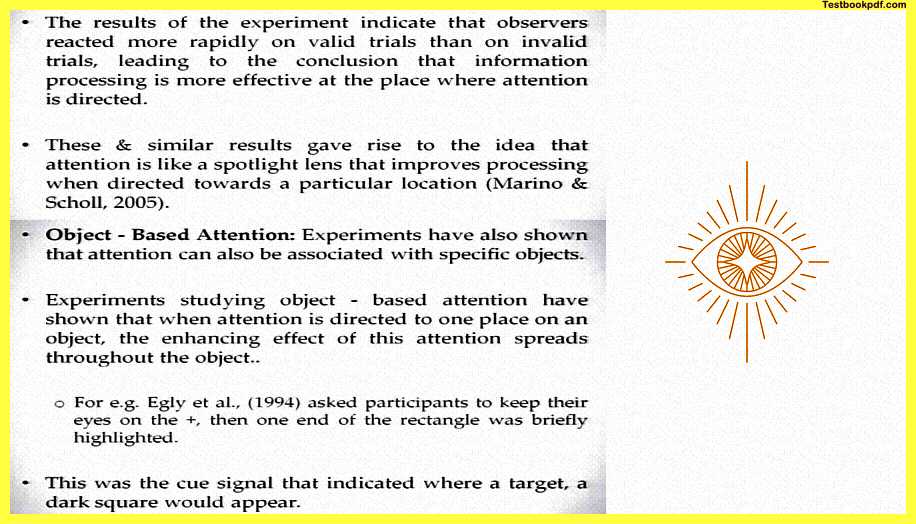
Now it has been seen that when participants are given tasks like these and there could be many variations valid queues are responded to much faster so people will respond much faster targets presented on pre queued locations because what has happened is even though you have not moved your eyes generally the time period is much lower as well our eye movements even though you have not moved your eyes you have shifted your attention to that pre cued location and that is why any stimuli presented at those locations are attended to faster and more accurately the results of these experiments indicate that observers were reacting more rapidly on valid trials than on invalid trials leading to the conclusion that information processing is more effective at the place where attention is directed these and other similar results have given rise to the idea that attention is like a spotlight it’s like a lens that improves processing when directed toward a particular location i was giving that example of a torch if you are in a dark room your attention is like a torch you put your attention somewhere that is the part you are getting most information out of now the other kind of attention one could talk about is object based attention.
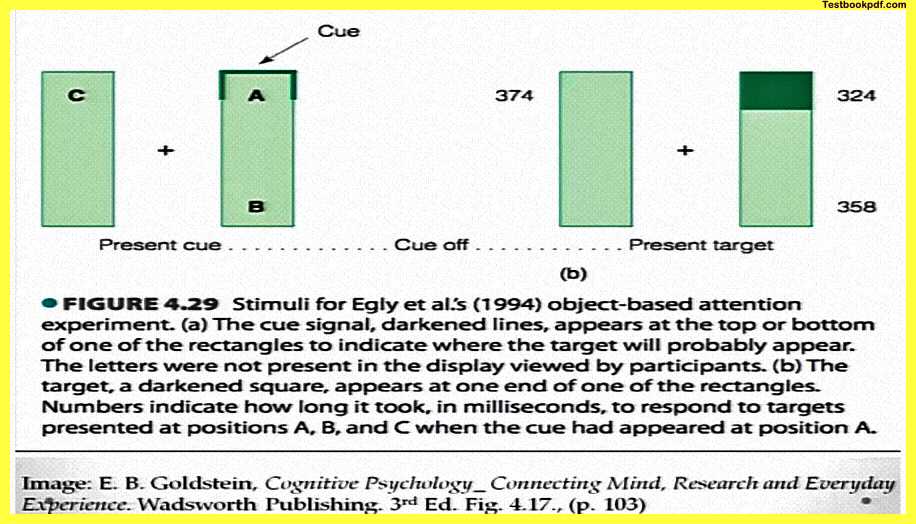
Now when you select a particular object experiments have also shown that attention can also be associated with specific objects experiments studying object-based attention have shown that when attention is directed to one place on an object the enhancing effect of this attention spreads throughout that topically looking at a particular pen or if you’re looking at a particular small object then the attention will kind of cover that entire object I’ll show you an example so Egly and colleagues they did this experiment they asked participants to keep their eyes on the fixation cross then on one end of the rectangle was briefly highlighted i will show you the figure right away this was the thing participants were basically asked to keep their eyes on the fixation cross but one end of these rectangles is brightly highlighted and there is where the target could appear ok so let us see let us see what happens i will just describe this in more detail so this basically this highlighting acts as a q signal that indicates where a target a dark square that is could appear and that is what they have to detect.
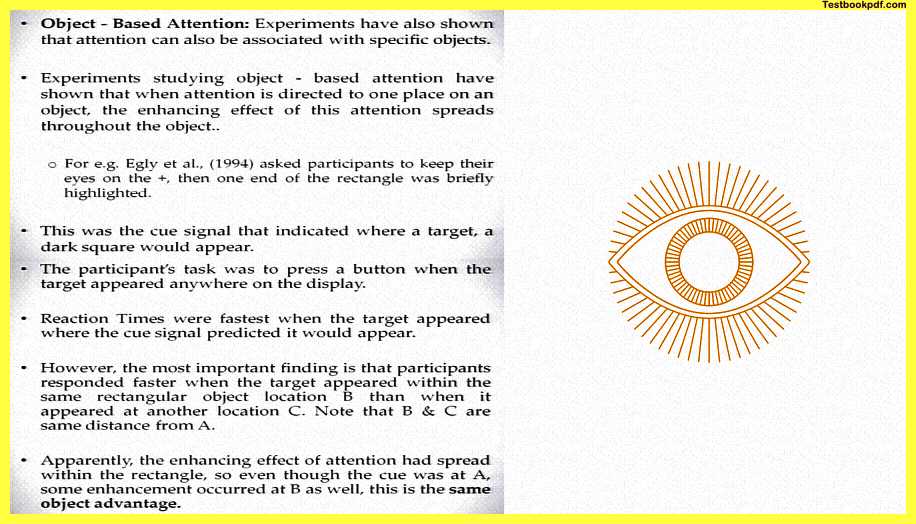
Now the participant’s task here is to press a button when the target appeared anywhere on that display the reaction times were found much faster when the target appeared where the q signal predicted that it would appear so again something similar to the last finding if you pre queue attention to a particular space or a particular object, in this case, your performance in terms of detection and accuracy is going to be much better however the most important finding however in this set of experiments is that participants responded to much responded much faster when the target appeared within the same rectangular object location b than when it appeared at another location c.
Now note that b and c are at the same distance from a so this is the thing if the object appeared in b versus the object that appeared in c participants were much faster at b even though the distance from b from a to b and a to c is exactly identical what is the difference, the difference is that b is lying on the same object as a or as the queued location but c is on a different object so this is the apparently enhancing effect of attention and that has spread within the entire rectangle so even though the q is at a spatial location or let us say on that particular object there is some enhancement occurring at b as well because b forms part of the same object this is basically called the same object advantage location and object basis.
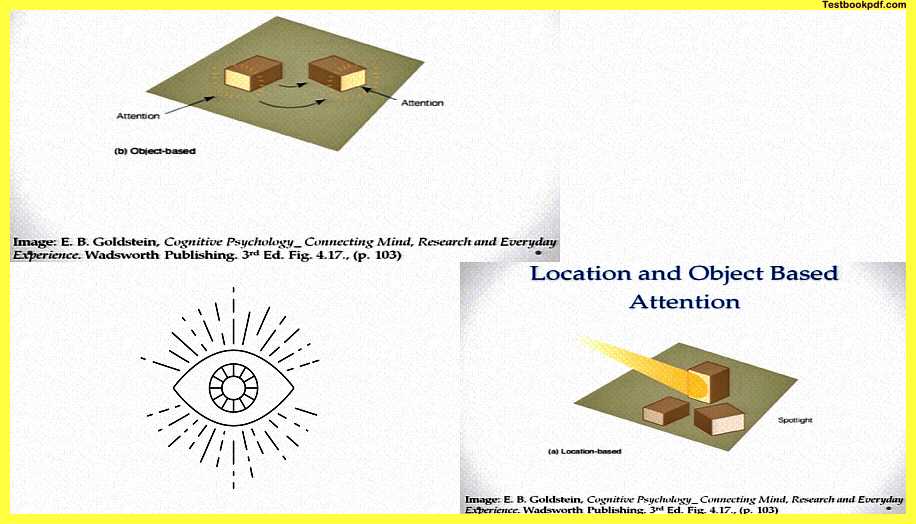
So, this is basically typically an example of location-based and object-based attention put together for you so location base is just like you are putting a spotlight at a particular location object basis when you’re looking at a particular object and your attention is enhanced throughout that particular object so if you move the object your attention moves along with the object in the location base if you change the location the attention does not really shift its a very specific location that you selected to attend so i hope these demonstrations i am kind of going to end here these demonstrations about how attention interacts and affects your visual perception might have been useful for you to realize how attention is an important process and how attention affects your abilities of perception as well similar examples would have also been taken with attention and auditory perception as well but i am not really talking about them because they are kind of not in the scope of the course thanks.
Read also:
Attention in Psychology Pdf (Part-1)
Attention Psychology Pdf (Part-2)
